Faucet with hygienic shower
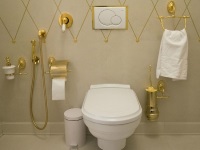
In some countries, such as Japan or South Korea, the set of standard bathroom equipment necessarily includes a bidet. Just like the toilet, bathtub and shower, it is an integral part of personal hygiene. In addition, the bidet is quite often found in European homes.
In our country this sanitary device is no longer considered exotic, but not yet widespread. It can often be seen in hospital or hotel bathrooms, but only a few people install it in their own apartments. This is largely due to the fact that our bathrooms are not rich in square meters. The area of a standard bathroom is often enough to fit only a toilet bowl and a bath or a shower cabin. Connecting additional plumbing becomes a real problem. That is why models that combine the functions of several devices at once are gaining in popularity. An example of such sanitary equipment - a toilet bowl with a hygienic shower.
Purpose
The hygienic shower represents shower hose with a watering can, which is connected next to the toilet bowl. It is equipped with a faucet with a valve or lever that allows you to adjust the temperature and water pressure. The hygienic shower is designed to replace toilet paper. It can also be used to perform routine feminine hygiene procedures.

Device
The hygienic shower has a fairly simple configuration. It consists of the following elements:
- The shower hose with a length of 50 to 150 cm. Budget models are made only of rubber, while more expensive models have a metal braid with a coating of bronze, brass, steel, etc.
- Showerhead equipped with a valve for water shutoff. Its dimensions are much smaller than usual, allowing you to comfortably use it for washing.
- A faucet equipped with a water temperature regulator.
- Optional elements are a non-return valve and a reducer.
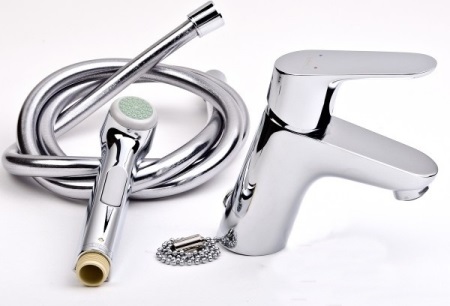
Pros of
- The main advantage of the hygienic shower over the bidet is to save space. After all, plumbing standards require the location of the bidet at least 30 cm from the toilet bowl and from the wall, and it is not always possible to implement in practice.
- Compared with the purchase of a bidet, the installation of a hygienic shower will cost very inexpensive, so when the budget is limited, it is better to opt for this option.
- Hygienic shower can be used not for its intended purpose. The owners of this device find him a very different application. For example, with his help, it is convenient to wash the toilet or fill a bucket of water.
- Using the hygienic shower allows you to reduce the consumption of toilet paper. In Arab countries for example there is no use of toilet paper at all, preferring the hygienic shower.
- Washing yourself with a hygienic shower is much more convenient and faster than doing it in the bathtub. In addition, you can not worry about getting "extra" parts of the body wet.
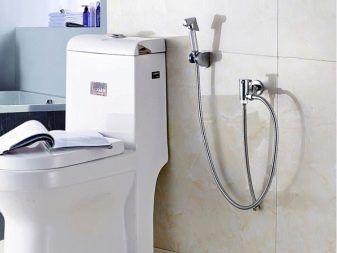
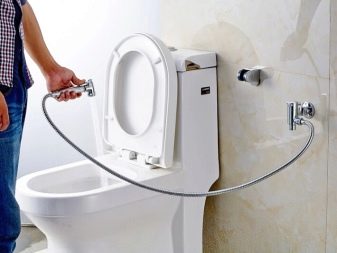
Disadvantages
- Not always the water from the hygienic shower stops flowing immediately after turning off. It also happens that for a few minutes it continues to drip a little bit from the shower head. This is usually due to the quality of the product or to the connection features. The problem is solved by installing a small tray, where the water will drain.
- If the shower head holder and the toilet paper holder are installed on the same side of the toilet, the latter will get soaked when water drips on it.
- It may take you a few days to get the hang of using a hygienic shower without splashing water all over the place. But the skill will surely come!
- Obese people may be uncomfortable using a hygienic shower, as there is little space left in the toilet opening to perform the necessary manipulations.
- Take the choice of a model of faucet with a hygienic shower very carefully. Some of them provide a connection only to hot or only to cold water. Which, of course, makes it almost impossible to use the device as intended.
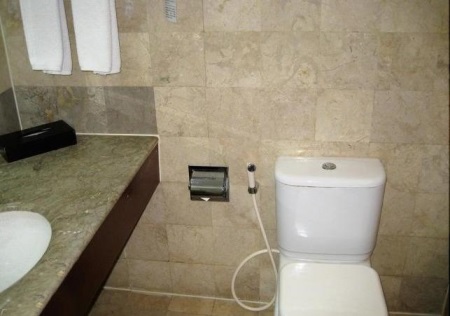
Installation methods
- Method 1. If you start to make repairs in the bathroom "from scratch", then you have the opportunity to connect a sanitary shower in the most convenient way. It assumes that the pipes with hot and cold water will be brought to the place of installation of the toilet in advance. Thus, the hygienic shower will not need to be connected to the sanitary cabinet. If the installation of the hygienic shower is planned in advance, you have more opportunities to implement technological and design solutions in the arrangement of the bathroom.
- Method 2. If the idea of installing a hygienic shower has arisen after the completion of construction work, no one, of course, will carry out a global restructuring of the room. In this case, the installation is made directly in the sanitary cabinet. The disadvantage of this method is that each time you turn on the hygienic shower you will have to re-adjust the temperature and water pressure. The problem can be solved by installing a mixer tap with a thermostat.
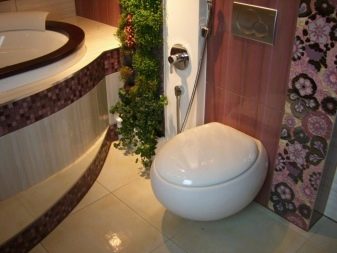
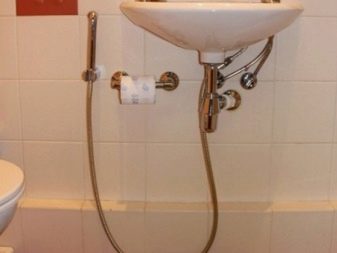
Types of faucets for hygienic shower
Depending on the design:
- Valve faucet. Is installed on the hygienic shower, if it is connected to the sanitary cabinet. Such a design has a lot of disadvantages. These include, first, the impossibility of maintaining a set water temperature without a thermostat; secondly, the need to connect a check valve to prevent cold water from getting into the hot pipe (and vice versa); thirdly, the need to connect another tap needed to supply and shut off water.
- Lever mixer is considered a more convenient option for installation and operation. It requires minimal work during installation and does not need to connect additional equipment. After all, the design features of such a mixer allow you to adjust the temperature and water pressure with only one lever.
- A faucet equipped with a thermostat. A more "advanced" option, which allows you to set a comfortable water temperature once and for all. Even if the pressure in the water pipes fluctuates, it will not change. All you have to do is change the pressure with a lever.
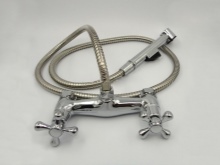
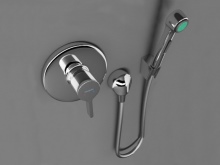
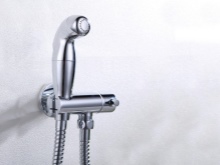
Depending on how you mount it:
- A faucet that connects to the sink. This type is suitable if the bathroom is adjacent or if the toilet has a washbasin. The model has two outlets, one of which is designed to release water, and the other - to connect the sanitary hose. On the shower head there is usually a button that starts and stops the water supply.
- Wall-mounted faucet choose when the toilet is the only sanitary device in the room.
Wall-mounted faucet has two modifications:
- Outdoor models. Mounted directly to the water pipes coming out of the wall. One end of it is connected to the pipe, and the shower hose is put on the other end.
- Built-in models with flush mounting, which are panels mounted on the wall. These panels conceal all communications. In order to install such a faucet, the water pipes must be concealed.
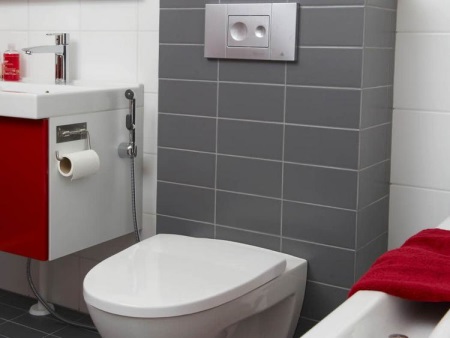
What to consider when choosing?
The first thing to consider when buying a hygienic shower is the size and plumbing equipment of the room in which the toilet is located. If the faucet is purchased for the toilet, it is recommended to buy a small washbasin as well (for example, a corner model). Installing the sink will greatly facilitate the installation of the hygienic shower and make it more comfortable to use.
Included with the hygienic shower, be sure to purchase convenient and beautiful holders for the shower head. The wealth of choice allows you to choose accessories that will match the overall style of the room.
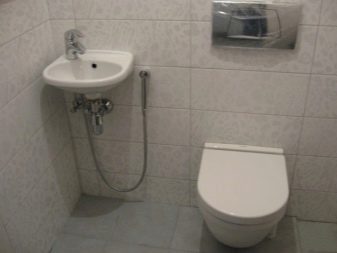
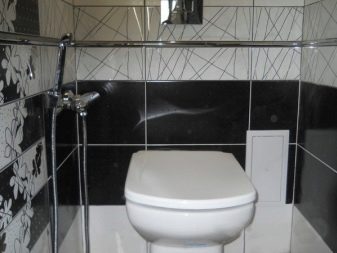
Installation
The easiest way to install a hygienic shower is to connect it to the sink.
It is made as follows:
- First you need to dismantle the old faucet on the washbasin, and replace it with a special model equipped with three outlets - for cold and hot water and for the shower hose.
- Next, you need to install a faucet for the hygienic shower on the sink. This is done in the same way as with a regular faucet, only a flexible shower hose is connected to the third outlet.
- After installing the faucet, you should install the shower head holder at a convenient height. To find the best position for it, sit down on the toilet and try to reach the wall.
The necessary fasteners for installation are usually sold with the holder.





